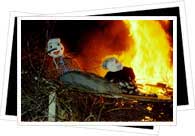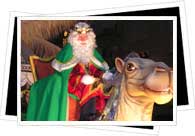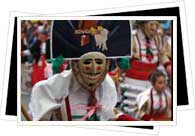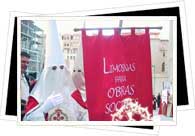
If there's one thing Spain knows how to do well it's throw parties- in fact, Spanish festivals almost have to fight for calendar space! Alicante's own calendar features a line-up of vastly different and yet equally exciting festivals. Alicante becomes a pyrotechnic wonderland during Las Hogueras, a medieval battleground during the Moors and Christians festival and an atmospheric stage for scores of arts festivals. So check out the calendar, see what's going on and dive right in to Alicante's sea of festivals!
-Las Hogueras de San Juan
-Santa Faz
-Moors and Christians
-Arts Festivals
Reyes Magos (Three Wise Men)
January 5-6 With lights decorating the streets, nativity scenes filling open spaces and festive music setting the astmosphere, young and old- but especially young- anxiously await the arrival of the Three Wise Men. On January 5th, Spaniards in cities throughout Spain celebrate the arrival of these religious monarchs with a colorful parade called the Cabalgata de los Reyes Magos. During this parade Melchor, Gaspar and Balthasar process through the streets on floats from which they throw sweets to the thousands of delighted children below. After the parade, children go to bed early- but not before leaving their shoes out in a spot where the Wise Men are sure to see them! When the sun comes up, those very children awake to discover that the Wise Men did indeed make a stop at their home to leave presents by their shoes.
With lights decorating the streets, nativity scenes filling open spaces and festive music setting the astmosphere, young and old- but especially young- anxiously await the arrival of the Three Wise Men. On January 5th, Spaniards in cities throughout Spain celebrate the arrival of these religious monarchs with a colorful parade called the Cabalgata de los Reyes Magos. During this parade Melchor, Gaspar and Balthasar process through the streets on floats from which they throw sweets to the thousands of delighted children below. After the parade, children go to bed early- but not before leaving their shoes out in a spot where the Wise Men are sure to see them! When the sun comes up, those very children awake to discover that the Wise Men did indeed make a stop at their home to leave presents by their shoes.
Carnaval (Carnival)
February-March From the city's major monuments right down to the street benches, Alicante and its people transform themselves during the festive Carnival. Costumes, street parties, music, masked balls and a huge parade down Rambla de Méndez Núñez are just some of what makes up the nearly two weeks of uninhibited fun. The last day is truly unique, as El Barrio fills to the brim with people donning masks and fancy dress for the Velatorio y Entierro de la Sardina (Funeral Wake and Burial of the Sardine), when the masks and the make-up are buried until the following year.
From the city's major monuments right down to the street benches, Alicante and its people transform themselves during the festive Carnival. Costumes, street parties, music, masked balls and a huge parade down Rambla de Méndez Núñez are just some of what makes up the nearly two weeks of uninhibited fun. The last day is truly unique, as El Barrio fills to the brim with people donning masks and fancy dress for the Velatorio y Entierro de la Sardina (Funeral Wake and Burial of the Sardine), when the masks and the make-up are buried until the following year.
Semana Santa (Holy Week)
March-April Holy Week in Alicante, while not as famous as those in Sevilla, is a beautiful time to be in the charming port city. While 20,000 people take to the streets for the processions, the music and the imagery every day, Holy Wednesday is perhaps the most beautiful as the processions make their way through the winding streets of Alicante's Santa Cruz neighborhood- no easy feat, as the steep and narrow streets have the added obstacle of 6,000 people packed in! On Holy Thursday, Spain's largest "paso" (adorned float with sculptures depicting scenes of Christ's passion) of the Last Supper comes out- and by large we mean that 208 "costaleros" (the men who carry the floats) are necessary to heave the 300 kilogram float through the city on their backs!
Holy Week in Alicante, while not as famous as those in Sevilla, is a beautiful time to be in the charming port city. While 20,000 people take to the streets for the processions, the music and the imagery every day, Holy Wednesday is perhaps the most beautiful as the processions make their way through the winding streets of Alicante's Santa Cruz neighborhood- no easy feat, as the steep and narrow streets have the added obstacle of 6,000 people packed in! On Holy Thursday, Spain's largest "paso" (adorned float with sculptures depicting scenes of Christ's passion) of the Last Supper comes out- and by large we mean that 208 "costaleros" (the men who carry the floats) are necessary to heave the 300 kilogram float through the city on their backs!
Cruces de Mayo (May Crosses)
May 1-3
The already picture perfect Santa Cruz neighborhood of Alicante fills with music, dancing and flowers during the annual Cruces de Mayo celebration. The cobbled streets, intimate plazas and picturesque balconies of this typical neighborhood take on a whole new look as they are decorated with flowers arranged into the shape of crosses. The atmosphere is festive and lighthearted- with sunny spring days, the scent of flowers filling the streets and music in the air how could it not be!
Mercado Medieval (Medieval Market)
Last week of June
Walking through the annual Medieval Market is like strolling straight back to the Middle Ages during this unique market. The streets of El Barrio, the section of Alicante which itself dates back to Medieval times, fill with music, clothing, food and more that you can't find anywhere else- at least not in this day and age! Costumed musicians and jugglers provide the entertainment and the festive atmosphere while the nooks and crannies of El Barrio lend themselves to stands selling and demonstrating traditional artisan crafts.
Virgen del Carmen
July 16
It's no surprise that a city that has relied on its seaside location for so many centuries pays homage to the patron saint of sailors! Fishermen and sailors in Alicante carefully adorn their boats, but the best place to see the celebration is on the nearby island of Tabarca, where the image of the Virgin sits majestically in her own boat in a sailor's procession!
Nuestra Señora del Remedio
August 3-5
To pay tribute to Alicante's patron saint, Our Lady of Remedy, an ancient choral concert called the Alborada is held followed two days later by the actual feast day, which features a beautiful procession featuring the sculptured image of the Virgin herself winds through the streets of Alicante.
Virgen del Socorro
September 6-10
The Raval Roig neighborhood, which was traditionally home to sailors and fishermen, plays center stage during this annual feast and celebration. Held to honor the neighborhoods patron saint, who lends her name to the neighborhoods main street as well as its chapel, festivities include dancing, music, food, fireworks and, not surprisingly, a procession!
Nochebuena / Navidad (Christmas Eve / Christmas)
December 24-25
As Christmas nears, the streets of Alicante shimmer with lights, nativity scenes decorate both public and private places and Christmas markets liven up large plazas. Entire families- grandparents, aunts, uncles, cousins, second cousins- get together for hours of intense eating and drinking during what's often the biggest meal of the year. A typical sweet finale is a turrón, a sweet toasted almond nougat and Alicante specialty for over five centuries!
After the food, the drink, the conversation and perhaps an hour or two of recuperation, people often continue the partying- in the home or heading out on the town- long into the night. Children may receive a couple of small presents, but the big gift-opening day on their minds is January 6: Reyes Magos (Three Kings).
Nochevieja (New Years)
December 31-January 1
Say adios to another year gone by in Alicante, where Spain's famous grape-eating tradition got its start! The typical New Years Eve starts off with huge family dinner at home, after which young people typically hit the town for the night with friends. Follow the hoards of festive party-goers, armed with champagne and grapes, to the Plaza del Ayuntamiento (City Hall Square) in El Barrio for the big countdown. Make sure you get a good view of the clock, because you've got to be ready to start popping those good-luck grapes in your mouth with each of the 12 strokes of midnight! Afterwards, bottles are uncorked, the champagne flows and everybody is your friend. After the Ayuntamiento festivities, Alicante's bars, discotecas and pubs are the places to be to ring in the new year.